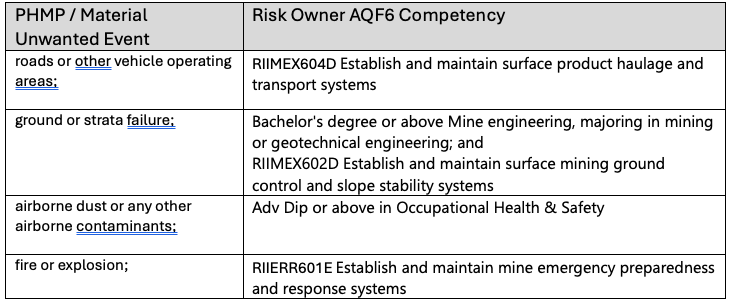PHMPs, Critical Controls and Risk Owner Competencies, what to do about the RSHQ questionnaire sent to SSEs today….
The article came about because of a recent questionnaire sent by Resources Safety & Health Queensland (RSHQ) to confirm that critical controls are being implemented into the PHMPs and that appropriate qualifications are held by the MUE owners for each PHMP.
Whilst this example is specific to Coal Mining operations in Queensland, Australia, the process is relevant to any organisation that is following a Critical Control management framework.
First, a quick recap of the relevant mining legislation in Queensland:
The Resources Safety and Health Legislation Amendment Act 2024 amended the CMSHA, 1 June 2025 to include the following changes:
Schedule 3 (Dictionary)
critical control means a risk control measure for a coal mine -
(a) that is critical to -
(i) prevent a material unwanted event at the coal mine; or
(ii) mitigate the consequences of a material unwanted event at the coal mine; and
(b) the absence or failure of which would significantly increase risk despite the existence of other risk control measures.
material unwanted event (MUE), at a coal mine, means an unwanted event in relation to which the potential or real consequence to safety or health exceeds a threshold defined by the coal mine operator as warranting the highest level of attention
s63 Principal hazard management plan
(1) A principal hazard management plan should—
(a) identify, analyse and assess risk associated with principal hazards; and
(b) include standard operating procedures and other measures to control risk; and
(c) include critical controls
Coal Mining Safety and Health Regulation 2017 defines what PHMPs must be in place. For a surface coal mine it is:
102A Principal hazard management plan
A surface mine must have principal hazard management plans that provide for at the least the following—
(a) roads or other vehicle operating areas;
(b) ground or strata failure;
(c) airborne dust or any other airborne contaminants;
(d) fire or explosion;
(e) any other principal hazard identified by the coal mine operator or site senior executive for the surface mine.
In addition, Recognised Standard 22 (Management Structure for the development and implementation of the Safety and Health Management System) requires a senior person to be nominated as the owner for each MUE, and in addition, the Site Senor Executive (SSE) shall state the requirements for that person to be deemed competent for that role – with strong wording that shall include units of competency at AQF6 or above from the Resources and Infrastructure Industry training package (RII).
How to answer the questionnaire:
1. The RSHQ Critical Controls and PHMP questionnaire requires you to confirm that for each listed PHMP you firstly have a PHMP in place. These PHMPs are the ones required under Coal Mining Safety and Health Regulation 2017 part 102A (surface mines) or Part 149 (underground mines).
2. Second question is to confirm that for each PHMP, you have integrated Critical Controls into the PHMP. This is explained in detail in QGN 35 (The Integration of Critical Controls into PHMPs for Coal Mines in Queensland).
3. Finally, the questionnaire requires you to confirm that a person with a competency as level AQF6 or above is appointed to manager that PHMP.
This third question comes primarily from Recognised Standard 22 requirements to appoint a SENIOR person as the Owner of each MUE (we call them “Risk Owners”).
AQF is the “Australian Qualifications Framework” - The AQF comprises 10 levels, ranging from certificates (level 1 – 4) to doctoral degrees (level 10). The important ones for now are Level 6 – Advanced Diploma / Associate Degree and AQF 7 – Bachelor Degree).
In addition, it is the author’s belief that the intent of RS22 is not that the nominated Risk Owner has to have the entire AQF6 qualification but rather it may be a unit of competence at the AQF6 level pertaining to the particular MUE that provides the knowledge transfer required by the Risk Owner to be ‘competent’ in their role with respect to the MUE.
What AQF6 level competency should be set for each PHMP?
This answer comes down to the individual Site Broad Brush Risk Assessment, the corporate tolerance to risk and the SSE’s own personal preference. But, our experience to date suggests the following competencies should be considered:
(again, for a surface coal mine):
Don’t hesitate to reach out to us via our website https://www.mycompetency.expert/
Or, you can read more about how My Competency Expert is used to ensure compliance with Recognised Standard 22 and s.55 of the CMSHA at https://www.mycompetency.expert/mce.
References:
Coal Mining Safety and Health Regulations 2017 (Qld). Retrieved July 9, 2025 from
https://www.legislation.qld.gov.au/view/html/inforce/current/sl-2017-0165
AQF qualifications. Retrieved July 9, 2025 from https://www.aqf.edu.au/framework/aqf-qualifications
QGN35 The Integration of Critical Controls into PHMPs for Coal Mines in Queensland, Retrieved July 9, 2025. https://www.rshq.qld.gov.au/__data/assets/pdf_file/0020/2044604/QGN35-The-Integration-of-critical-controls-into-phmp-coal.pdf
Resources Safety and Health Queensland Recognised Standard 22 Management Structure for the
development and implementation of the Safety and Health Management System. Retrieved July 9, 2025 from https://www.rshq.qld.gov.au/resources/documents/mines-resources/safety-and-health/legislation,-standards-and-guidelines/recognised-standards-coal-mines/recognised-standard-22.pdf
RII Resources and Infrastructure Industry Training Package. Retrieved July 9, 2025 from https://training.gov.au/training/details/rii/summary

